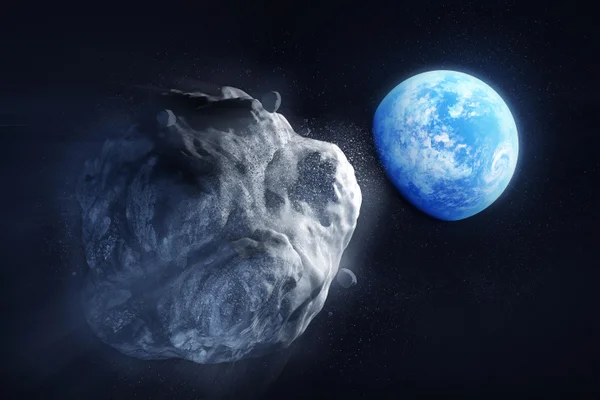Published
2 days agoon

When astronomers discovered asteroid 2024 YR4 hurtling towards Earth in December, they knew they had something worth watching. Now, months later, global space agencies—including NASA and the European Space Agency (ESA)—have flagged it as a potential ‘city killer’. While the probability of impact is still relatively low, the chances have been rising, causing increasing concern.
NASA, along with other space agencies, is set to closely monitor 2024 YR4 using the James Webb Space Telescope in March and May 2025. The asteroid, estimated to be between 40 and 90 meters wide, could unleash energy equivalent to 7.7 megatonnes of TNT—enough to flatten a city.
Initially, ESA estimated the asteroid had a 1% chance of striking Earth. NASA’s Jet Propulsion Laboratory later revised the probability to 2%. The asteroid is expected to make its closest approach on December 22, 2032. While the odds are still in favor of a harmless flyby, the fact that its impact probability is increasing has led astronomers to keep a close watch.

India in the ‘Risk Corridor’
If 2024 YR4 were to collide with Earth, scientists have mapped out a ‘risk corridor’—a vast stretch of land and ocean where an impact is most likely. This corridor spans northern South America, the Pacific Ocean, southern Asia, the Arabian Sea, and parts of Africa. Notably, India falls within this risk corridor, along with Pakistan, Bangladesh, Venezuela, Colombia, Ecuador, Sudan, Nigeria, and Ethiopia.
Understanding the Risk. The Torino Scale
To assess asteroid threats, astronomers use the 11-point Torino Scale, which ranks potential impacts based on their likelihood and potential consequences. While most objects on NASA’s risk list have a rating of 0 (meaning no danger), 2024 YR4 currently holds a rating of 3—indicating an event that warrants continued monitoring.
For context, a rating of 8-10 means an unavoidable, catastrophic impact; 5-7 signals a significant but uncertain threat; 2-4 requires monitoring; and 0-1 means no cause for concern.
Potential Impact. What Happens If It Hits?
The extent of damage from an asteroid impact depends on its size, composition, speed, and impact location. Current estimates suggest 2024 YR4 could trigger an airburst explosion equivalent to eight million tonnes of TNT—roughly 500 times the power of the Hiroshima bomb. Such an explosion could devastate an area spanning 50 kilometers from the impact site.
“Probably the nearest parallel we have in kind of recorded history would be the Tunguska event rather in 1908,” said Dr Richard J. Wilman, Department of Physics, Durham University, in an interview. “An object about 100 meters in diameter entered the Earth’s atmosphere and exploded as an airburst, destroying 2,000 square kilometers of Siberian forest.” As Wilman points out, that’s roughly the area within the M25 motorway around London.
Stony asteroids — which 2024 YR4 likely is — tend to explode before they strike Earth. If it’s made of harder stuff, then it could strike Earth and cause a crater. “It depends on the type of asteroid, but as a rule of thumb, the size of a crater is about 20 times the size of the impacting body,” said Wilman. “So if you had a 100 meter diameter asteroid, that will give you a crater diameter of two kilometers.”
If the asteroid were to strike an urban area, the destruction would be massive, but if it landed in an ocean or remote region, the impact might be less catastrophic. However, even an oceanic impact could generate dangerous tsunamis.
Can We Stop It? The Global Response to Asteroid Threats
NASA’s first mission to test planetary defense technology, the Double Asteroid Redirection Test (DART), resulted in a successful impact with asteroid Dimorphos on Sept. 26, 2022, which changed its orbit.
Can we do the same with 2024 YR4? It’s a possibility in 2028. If it is a rubble-type asteroid, a kinetic impact could make the situation worse.
“The moment you impact it, it starts falling apart, and then instead of having a single rock of 40 meters or 50 meters, you may have multiple rocks of smaller size — and you cannot predict what will happen to all these smaller pieces,” said Luca Conversi, NEO Coordination Centre Manager and NEOMIR Study Scientist at the European Space Agency’s ESRIN site in Frascati, Italy, in an interview.
That would be the least effective, most dangerous solution to be used only in a last resort.
“There are two problems with a nuclear bomb,” said Conversi. “First of all, it was never tested.”
There is also a huge political implication. “If we launched a DART-like spacecraft and it fails, tough luck, but what if the launch is carrying a nuclear bomb and it explodes in the higher atmosphere?” said Conversi. “You’re taking a risk, and you want to be sure that the risk you are taking is worth the effort.”
China Takes Action
China has taken a significant step in planetary defense by initiating a recruitment drive for a specialized force aimed at tackling potential asteroid threats. This move comes after thorough risk assessments indicated that an asteroid—potentially on a collision course with Earth in 2032—could pose a credible danger.
The job postings, which surfaced on WeChat, have sparked significant discussion among China’s youth, a group struggling with record-high unemployment rates in recent years. While some saw the opportunity as a high-stakes mission to protect the planet, others commented humorously about the overwhelming responsibility it entails.
Beyond recruitment, China has been advancing its planetary defense capabilities through research, monitoring systems, and experimental asteroid deflection technologies. The country is actively developing methods similar to NASA’s 2020 Double Asteroid Redirection Test (DART), which successfully altered the trajectory of an asteroid by crashing a spacecraft into it. China’s own test mission, set for 2027, will target a smaller asteroid, 2015 XF261, to assess deflection efficacy. However, some experts, such as planetary scientist Harrison Agrusa, have expressed concerns that targeting smaller asteroids may result in fragmentation, potentially adding to the threat rather than neutralizing it.



China’s Economy On Its Way To Recovery? Alibaba Shares Soar 11% After Stellar Earnings, Marking an E-Commerce Revival—But What About the Pained Real Estate Sector?


Why Are Japanese Companies Not Happy With Trump? How Trump 2.0 Is Shaking The World Into A ‘Rude’ Awakening?


Taiwan Gears Up For A Major Military Deal With The US—Trump’s New Taiwan Stand Rattles China! Is Another Ukraine In The Making?


Is Trump Right About China Controlling The Panama Canal? Well, Not Exactly!


Trump’s Commendable Proposal. A Summit With Putin And Xi Jinping To Halve Military Budgets—Arms Reduction, Can It Happen?


Modi And Trump 2.0, Bromance In Full Display? Key Takeaways From Trump-Modi Meeting. Oil—The Big Question, United States Or Russian Oil?
